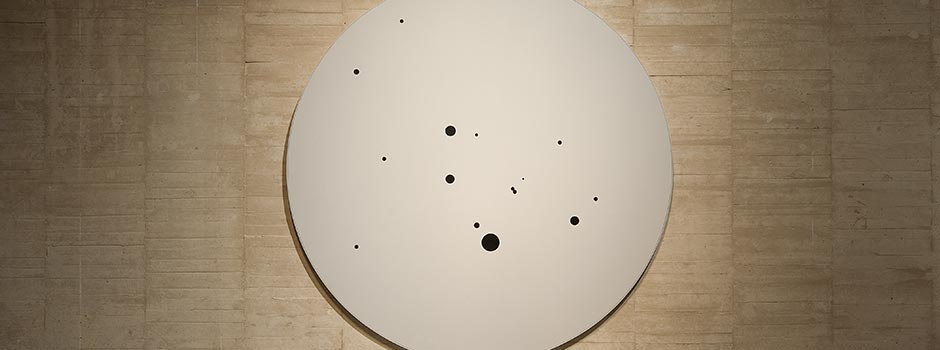
ART FAIR (27 Feb - 1 March 2020) ARCOmadrid 2020 - Sabrina Amrani Presents Museum-Quality Works
Feb 22, 2020 EVENT, Art Fair

The presentation at the booth begins with Manal AlDowayan, a Saudi artist whose artistic practice revolves around themes of active forgetting, archives, and collective memory. Her main focus lies on the state of women and their representation. Embracing diverse media, Manal AlDowayan’s work encompasses black and white photography, sculpture, video, sound, neon, and large-scale participatory installations. For ARCOmadrid the gallery will present work from her most iconic series “Suspended Togetherâ€, an installation sculpture in porcelain of 10 standing and pecking doves stamped with the travel permit issued by male relatives, that allow Saudi women to travel. Her artworks are part of public collections at the British Museum in London, LACMA in Los Angeles, Louisiana Museum in Denmark, and MATHAF Museum in Doha, to name a few.
_2008.jpg) Manal AlDowayan, Suspended together (Standing Dove), 2008. Printed porcelain, 18 × 20 × 32 cm. Editions 10, 14 of 40 + 1AP. Courtesy of the artist and Sabrina Amrani
Manal AlDowayan, Suspended together (Standing Dove), 2008. Printed porcelain, 18 × 20 × 32 cm. Editions 10, 14 of 40 + 1AP. Courtesy of the artist and Sabrina Amrani
The presentation continues with the work Les Horizons Complexes (de l’Amour et d’une romance), a series of colourful textile pieces by Joël Andrianomearisoa, who represented Madagascar at the first-ever pavilion of the country at La Biennale di Venezia this year. The artist’s work develops around a non-explicit, often abstract narration, which everyone perceives, yet cannot put a name to. His world of forms weaves his work into sequences deeply mired in the concepts of sentimentality, feelings and memory. In 2020 the artist will begin the year with a solo exhibition at Dallas Contemporary Museum in January, then he will participate with a major installation in the Biennale of Sydney in March, and will also have three more solo exhibitions at Chateau de Chaumont Musée National, Musée d’Art Clermont Ferrand, and Chateau Aigues Mortes, all of them in France. Joël Andrianomearisoa works are in public collections such as the Studio Harlem Museum in New York, National Museum of African Art in Washington DC and Zeitz MOCAA in Cape Town.
-I-2018.jpg) Joël Andrianomearisoa, Les Horizons Complexes (de l’Amour et d’une romance) I, 2018. Textiles, 190 × 130 cm. Courtesy of the artist and Sabrina Amrani
Joël Andrianomearisoa, Les Horizons Complexes (de l’Amour et d’une romance) I, 2018. Textiles, 190 × 130 cm. Courtesy of the artist and Sabrina Amrani
-VII-2018.jpg) Joël Andrianomearisoa, Les Horizons Complexes (de l’Amour et d’une romance) VII, 2018. Textiles, 190 × 130 cm. Courtesy of the artist and Sabrina Amrani
Joël Andrianomearisoa, Les Horizons Complexes (de l’Amour et d’une romance) VII, 2018. Textiles, 190 × 130 cm. Courtesy of the artist and Sabrina Amrani
The gallery showcases the latest work by Gabriela Bettini, “El Proceso†a series of works that continue her study of the first cultural colonialisation, and how it relates to its present-day legacy. Using the history of painting and the representation of landscape as her point of departure – observing how this medium has been used to reinforce the ideas that form the basis of Western hegemony – she analyses today’s environmental crisis and the extractivist model it supports, one where women become a paradigm of the multiple violence, inflicted by climate change. Her work is part of public collections as DKV Collection and Fundación Bancaria Caja de Extremadura in Spain and the Basmoca Museum in Saudi Arabia.
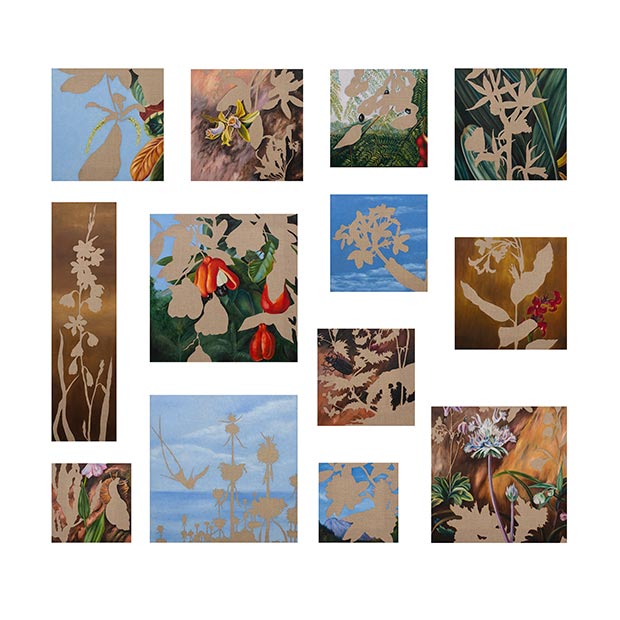 Gabriela Bettini, El Proceso- mural 1, 2020. Oil on linen, 156 × 162 cm. Courtesy of the artist and Sabrina Amrani
Gabriela Bettini, El Proceso- mural 1, 2020. Oil on linen, 156 × 162 cm. Courtesy of the artist and Sabrina Amrani
Several works by Babak Golkar are also part of the presentation, from his series of works “Time Capsules 2016-2116â€, which questions the notions of value creation and the role of the artist in governing these systems. Through the artist’s use of time as a key connecting material, all works unpack dominant geopolitical issues that have emerged through his close engagement with each object and their associated histories. Varying in scale and form, each work in “Time Capsules 2016-2116†contains a concealed artwork unknown to anyone but the artist. It is ill-advised to unveil their interiors until the suggested time has passed, inevitably outliving the artist and those who initially acquire the work. The artist is currently showcasing his third solo show at the gallery. His works are part of public collections as ARTER in Turkey and Vancouver Art Gallery in Canada.
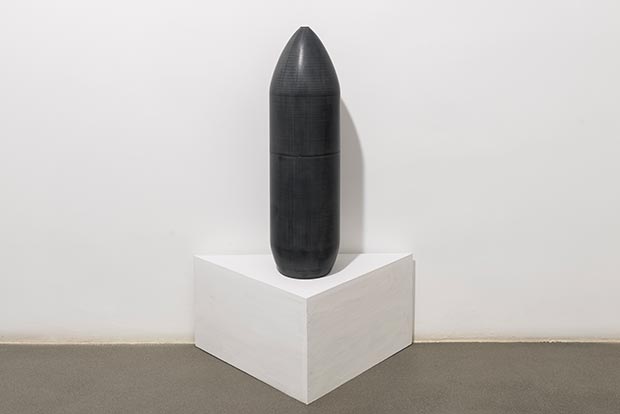 Babak Golkar, Neo-futurism, 2016-2116. ABS and concealed object, 76 × 21 × 21 cm. Courtesy of the artist and Sabrina Amrani
Babak Golkar, Neo-futurism, 2016-2116. ABS and concealed object, 76 × 21 × 21 cm. Courtesy of the artist and Sabrina Amrani
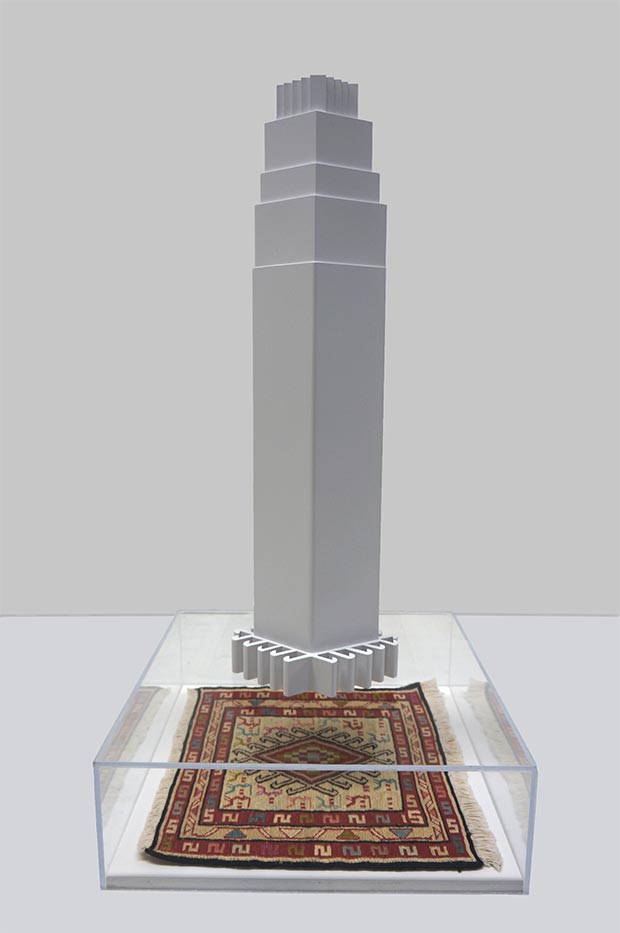 Babak Golkar, Negotiating the Space for Possible Coexistences No. 8, 2016. Persian carpet, plexiglass, wood and laquered paint, 55.9 × 50.8 × 101.6 cm. Courtesy of the artist and Sabrina Amrani
Babak Golkar, Negotiating the Space for Possible Coexistences No. 8, 2016. Persian carpet, plexiglass, wood and laquered paint, 55.9 × 50.8 × 101.6 cm. Courtesy of the artist and Sabrina Amrani
The gallery showcases works by South-African emerging artist Alexandra Karakashian. Her work derives from her family history and reflects on current issues of exile, migration, and refugee status. Employing used engine oil and salt as mediums for painting, she engages in the environmental discussion: the threatening instability and the subtle collapse of the planet, and the rapid depletion of natural resources. Her works are part of prominent public institutions, like Iziko South African National Gallery in Cape Town, Knights Bridge International in Los Angeles, and the Luciano Benetton Collection in Treviso.
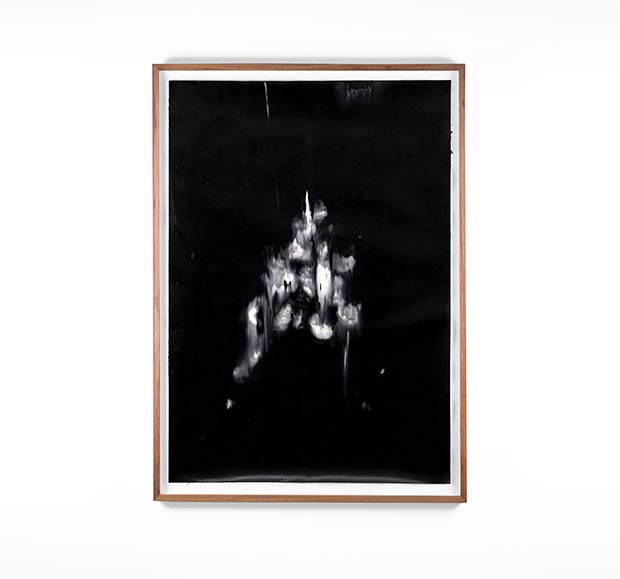 Alexandra Karakashian, Undying XL. Oil on Sized Paper, 99 × 70 cm. Courtesy of the artist and Sabrina Amrani
Alexandra Karakashian, Undying XL. Oil on Sized Paper, 99 × 70 cm. Courtesy of the artist and Sabrina Amrani
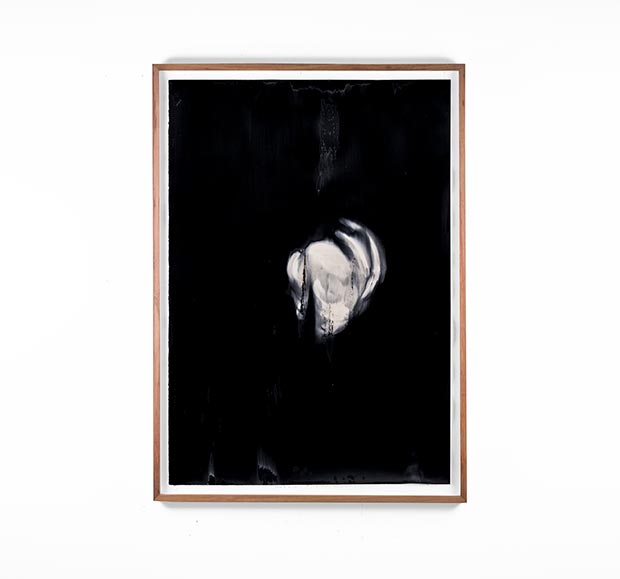 Alexandra Karakashian, Undying XLVIII. Oil on Sized Paper, 99 × 70 cm. Courtesy of the artist and Sabrina Amrani
Alexandra Karakashian, Undying XLVIII. Oil on Sized Paper, 99 × 70 cm. Courtesy of the artist and Sabrina Amrani
The presentation includes the latest large-scale intricate drawing by Pakistani artist Waqas Khan. Waqas Khan’s work resembles webs and celestial expansion. Khan employs small dashes and minuscule dots to create large entanglements. When two units are spread out and entangled, they are essentially ‘in sync’ with each other, and they’ll stay in sync no matter how far apart they are. Khan’s work also evokes a sense of scripting, which he likes to see as a discourse between him and his viewer, a dialogue which is very much formatted over the syntax of a monologue. The artist is increasingly working on monumental pieces, on acrylic canvases, where the ink from the artist’s stroke reacts uniquely with the surface. His work has been recently shown at the Asia Pacific Triennale at the QAGOMA in Brisbane, and he had his second solo show in a museum at MUSAC in León (Spain) in late 2019. Waqas Khan’s works are already part of prominent institutions like The British Museum and Victoria and Albert Museum in London, Kiran Nadar Museum of Art in New Delhi, The Whitworth and Manchester Museum in Manchester, and Deutsche Bank Collection in Frankfurt, to name a few.
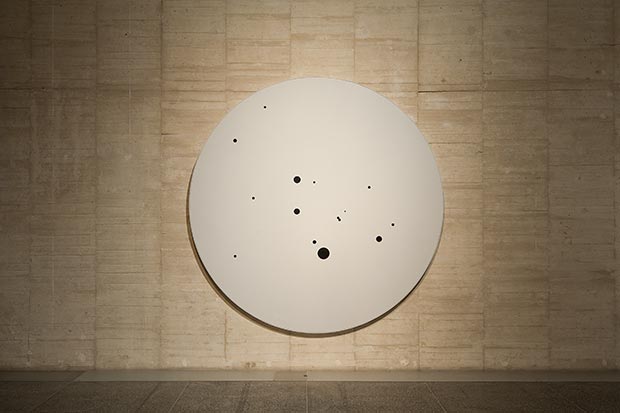 Waqas Khan, The Library Has No Letters, 2019. Ink and acrylic on canvas, 233 cm diameter. Courtesy of the artist and Sabrina Amrani
Waqas Khan, The Library Has No Letters, 2019. Ink and acrylic on canvas, 233 cm diameter. Courtesy of the artist and Sabrina Amrani
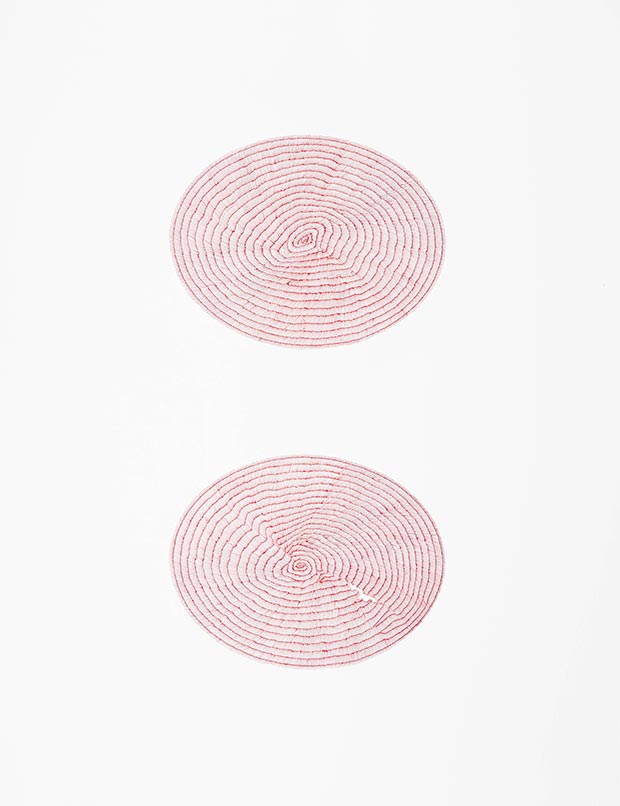 Waqas Khan, Dancer's Eye, 2014. Archival red ink on wasli paper, 68 × 53 cm. Courtesy of the artist and Sabrina Amrani Gallery
Waqas Khan, Dancer's Eye, 2014. Archival red ink on wasli paper, 68 × 53 cm. Courtesy of the artist and Sabrina Amrani Gallery
The gallery also presents a watercolour painting by Korean emerging artist Timothy Hyunsoo Lee, consisting of different cell-like marks that vary in size, colour, and saturation. His works are perceived at first as ethereal and delicate, but the extreme labour-intensive compositions, marked by intensely obsessive repetitions, quickly change that initial perception. Timothy Hyunsoo Lee has been part of major group shows in the Studio Museum Harlem in New York and the Young Arts Foundation in Miami.
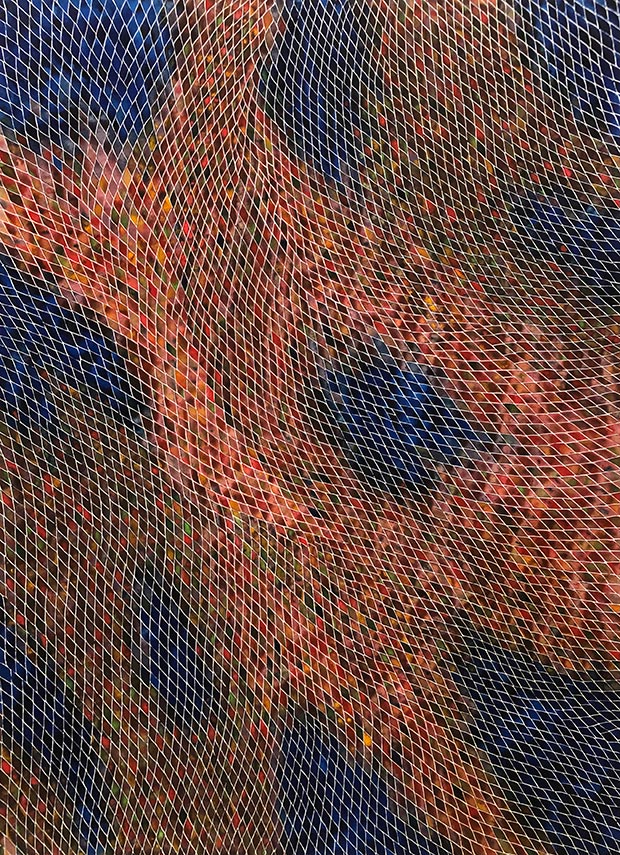 Timothy Hyunsoo Lee, Traces IV, 2019. Watercolor on paper, 130 × 95 cm. Courtesy of the artist and Sabrina Amrani
Timothy Hyunsoo Lee, Traces IV, 2019. Watercolor on paper, 130 × 95 cm. Courtesy of the artist and Sabrina Amrani
The presentation continues with Mónica de Miranda’s photographs from her series 'Panorama'. She explores the geographical, social and historical study of Luanda -the connections between the past and present memories of the city- to create an awareness of the country’s history and to convey our relationship to history through colonial buildings and the country’s most iconic landscapes. Among the historical layers, that we can see in these buildings, we can contemplate colonialism, independence, the post-cold war period of the post-civil war. A complicated framework that could lead us to imagine a different future. Her work is present in public collections like the Fundaçao Calouste Gulbekian, Museu Nacional de Arte Contemporânea do Chiado, and Arquivo Municipal de Lisboa.
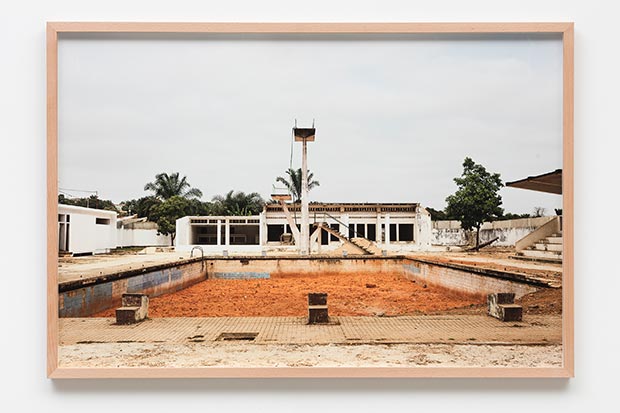 Mónica de Miranda, Swimming pool, 2017. Inkjet print in fine art paper, 70 × 105 cm Edition 5/6. Courtesy of the artist and Sabrina Amrani
Mónica de Miranda, Swimming pool, 2017. Inkjet print in fine art paper, 70 × 105 cm Edition 5/6. Courtesy of the artist and Sabrina Amrani
 Mónica de Miranda, Springboard, 2017 Inkjet print in fine art paper. 50 × 75 cm. Edition 5/6. Courtesy of the artist and Sabrina Amrani
Mónica de Miranda, Springboard, 2017 Inkjet print in fine art paper. 50 × 75 cm. Edition 5/6. Courtesy of the artist and Sabrina Amrani
A suspended minimal sculpture by Korean artist Jong Oh is also part of the presentation. His practice is quite particular since he does not use a studio but creates minimal sculptures onsite that respond to a given spatial situation. Responding to the nuanced configuration of each site, the artist constructs spatial structures by suspending and interconnecting a limited selection of materials: rope, chains, fishing wire, perspex, wooden and metal rods, and painted threads. The elements of the work seem to float, and depending on the spatial relationship of the viewer with it, these elements are connected and cross each other or appear as absolutely independent, suggesting additional dimensions to the simple three-dimensional space. He recently had his first solo museum show in Asia at Seoul Museum of Art (SeMA) in Seoul and has been part of major group exhibitions at Art Sonje Center in Seoul, Museum SAN in Wonju (Korea), ARTER in Istanbul, ZKM Center for Art and Media in Karlsruhe, and DeCordova Sculpture Park and Museum in Lincoln, Massachusetts. His works were recently acquired by the National Gallery of Victoria in Melbourne and will be on show at the museum during 2020.
-9_2020.jpg) Jong Oh, Line Sculpture(column) #9, 2020. Metal rod, chain, fishing wire, 194.5 × 30 × 30 cm. Courtesy of the artist and Sabrina Amrani
Jong Oh, Line Sculpture(column) #9, 2020. Metal rod, chain, fishing wire, 194.5 × 30 × 30 cm. Courtesy of the artist and Sabrina Amrani
The presentation concludes with two signature large-scale watercolour works by established artist Dagoberto RodrÃguez (formerly part of the Cuban collective Los Carpinteros). Combining architecture, design, and sculpture, his work employs humour and irony to comment on core topics in art, politics, and society. Watercolour is a very important part of his creative process, a way of registering and revising his ideas. His work is part of numerous international public collections, like the MOMA, Whitney Museum of American Art and Guggenheim Museum in New York, Hirshorn Museum in Washington DC, Museo Centro de Arte Reina SofÃa in Madrid, Tate Modern in London, and Centre Georges Pompidou in Paris. The artist is currently having his first solo exhibition at the gallery and will have a solo show in CAAM in March 2020.
 Dagoberto RodrÃguez, Corredor 19, 2020. Watercolor on paper, 200 × 260 cm. Courtesy of the artist and Sabrina Amrani
Dagoberto RodrÃguez, Corredor 19, 2020. Watercolor on paper, 200 × 260 cm. Courtesy of the artist and Sabrina Amrani
 Dagoberto RodrÃguez, Joya Roja, 2019. Watercolor on paper, 130 × 130 cm. Courtesy of the artist and Sabrina Amrani
Dagoberto RodrÃguez, Joya Roja, 2019. Watercolor on paper, 130 × 130 cm. Courtesy of the artist and Sabrina Amrani
Comments
Add a comment